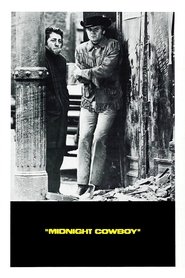— You're gonna tell me John Wayne's a fag?!
No less tragically anachronistic and delusional than Don Quixote, Joe also achieves greatness by way of his kinship to a man who’s his apparent opposite. His Sancho Panza—that is to say, the earthier and jaded counterpart with whom the idealist hero establishes a deep and complex relationship through dialogue—is Enrico “Ratso” Rizzo [Indeed,] screenwriter Waldo Salt spent years before Midnight Cowboy trying—and failing—to adapt Don Quixote. It’s through talking that Don Quixote and Sancho Panza find meaning in life, transcending the chivalric literature they’re dually emulating and parodying. It’s a theme that’s perfectly appropriated in Midnight Cowboy. Philosopher György Lukács said that Cervantes set his action in a world that’s been “abandoned by God,” and what better way to describe this film’s vision of America? “Everyone’s talkin’,” sings Harry Nilsson on the soundtrack during the opening credits, but no one’s really listening. And yet, human sympathy, however fleeting, finds a place within the film’s frames in the end, as the reflection of Ratso’s Florida paradise is superimposed over a fraught Joe holding his dead friend’s body.
— Niles Schwartz (Slant Magazine)
What they needed [in Joe Buck] was an actor who had a surface air of innocence yet the possibility of violence inside him.
— Glenn Frankel: Shooting Midnight Cowboy Art, Sex, Loneliness, Liberation, and the Making of a Dark Classic (2021)
Both Schlesinger and I came from the Neo-Realistic thought about film and I admired Italian cinema of the 1950s and 60s, and later the British cinema of the 60s and 70s. When we sat down with the script, Schlesinger and I connected on a creative level, and we were both coming to New York as foreigners, Schlesinger from London and I from Poland. As a result we had a curiosity for the city and came at it with fresh eyes; what Joe Buck sees at the start of Midnight Cowboy and how he sees it is pretty much how we saw the city as outsiders. We translated our own experiences onto the screen.
— Director of Photography Adam Holender
English director John Schlesinger, in spite of his skill with actors, was designated as a bad object by Anglo-American auteurists such as myself — crassly derivative of the French New Wave in his flashy effects and a tireless trend-monger. And some of my gay and bisexual friends objected to the ways in which this touching asexual/heterosexual love story between two failed street hustlers harped too much on the alleged shame of being homosexual.

